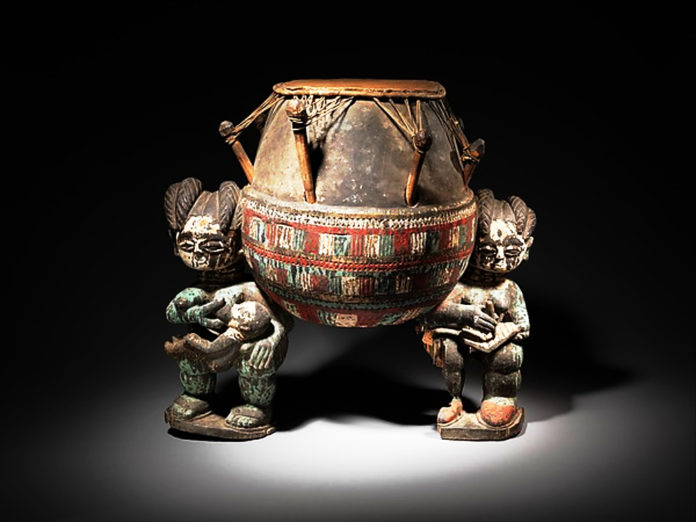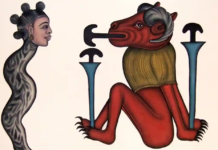NTOABOMA—I was seven, meandering through the thick of the sacred grounds in Ntoaboma—the sacred forest of rituals. It was situated at the edge of town and rarely any kid wandered there. For fear and that was good reason. On festive occasions (the only time we got to see it) rituals, prayers and libations were poured in this forest, which was bordered by a single footpath that split in two opposite directions on one end: in one direction to enter Ntoaboma proper, and in the second direction, to exit Ntoaboma from the East-side. The tales grandparents told their children—about the nature of the Gods and Spirits in this sacred forest—terrified every soul. In retrospect, all the stories were carefully calculated to instill the maximum fear in all who heard it. It was meant to reduce the human environmental footprint there, since it was located at the banks of The Amu, which Ghanaians now call the Volta River. The banks of The Amu were considered sacred grounds no matter the village you visited along the river.
I came across a drum in a pristine shrine. I would later describe the drum to my great grandmother who was ever intrigued by my loitering into forbidden grounds. She seemed to think that—through telepathy—the Gods were trying to make a disciple of me. I had my own conviction however: If the Gods can protect the sacred grounds in such terrifying manners; if the can put old men into copious amounts of trepidation, then they must be powerful. I wanted to meet them. Perhaps, I was rather telepathically communicating with the Gods.
As I studied the drum, the next thing, I felt the hook of a talking drum stick around my neck pulling me towards the entrance of one of the ritual halls. “What’s your name?” whispered a giant old man, clad in immaculately brushed gray hair, with a walking stick in the other hand pulling me towards him. I lifted my chin, squared my shoulders—thinking I had come into direct contact with one of the Gods—and looked him straight in the eye, “Narmer.” I replied. He studied me carefully, noticing that I wasn’t afraid of him. I wasn’t frightened although it seemed his whole intention was to terrify me. I thought to myself, well, Gods are supposed to be powerful and terrifying people came with that territory. I had wandered there myself and I saw no need to be afraid of the old man. “Run son, run, or Mother Yaa will cut off your head. You are trespassing.” I sprinted off, relieved that the test was over and smiling that I still had my head squarely situated where it was before I entered the forest. “Wow, what if that was some manifestation of the God of Dwarfs?” I thought to myself. In this forest there were many tales of not only ghostly apparitions, but of dwarfism. I found that fascinating but my own research as a child revealed none, which is another way to say the dwarfs, or the ghosts, weren’t particularly enamored by my presence.
When I got home, I had to recount the whole encounter to great grandmother. But of course, after scolding me for annoying the Gods, for trespassing, and for pissing off Asase Yaa Herself (who could have cut off my head, but didn’t), she became more interested above everything else in my description of the drum I saw. Not the old man. Not the hooking of my neck. Not the threat of Mother cutting off my head. Not the petrifying look of the old man. Not my seeming courage in the face of isolated danger. Not my seeming bravery in my attempt to dine with dwarfs on sacred grounds. I found great grandmother’s lack of attention to these details rather baffling. It was as if she believed in due time that I would naturally come to understand the deeper wisdom in the whole encounter with the old man. One that should involve respecting and safeguarding some of the pristine grounds of Asase Yaa without question.
My great grandmother asked, rather slowly, waving me towards her seat: “What drum did you say you saw?” At this point I knew I had to be careful. I had to muster all the vocabulary I had been socialized with to describe what I thought I saw. My great grandmother had always emphasized at home the meaninglessness of words. And that words become only meaningful when they were set in a particular pattern. That is, words must have some sort of rhythm in order to be meaningful. The same applies to any music. Consider beating a drum, the beats in themselves are meaningless unless of course they were arranged in a certain pattern with a certain regularity to convey a certain piece of information. Talking drums are sublime examples of the nature of this concept. Words, or beats in themselves mean nothing.
Take for another instance a language like Swahili spoken by over a hundred million people in the great lakes region. The grammatical and syntactic structure of the language is typically Bantu, but the vocabulary is mixed, some lexical terms are even in Arabic, which were mostly borrowed after the fifteenth century. But Swahili remains a Bantu language not because of its vocabulary, but its rhythm, its grammatical and syntactic structure. In the same way Ewe and Twi, which are both spoken in Ntoaboma, and Dagbani, all remain Bantu languages no matter how many English words have infiltrated them since the emergence of the new species, The More Educated Than His Ancestors (The Metha). So words in themselves mean nothing, except when they are ‘beaten’ together in a particular rhythmic pattern.
Besides, when a great grandmother asks a question very slowly, in Ntoaboma, it means something much more. “What drum did you say you saw?” can mean different things depending on who’s asking and how slowly the question is asked. In fact it can also depend on how the speaker drags each word. In this case I knew my great grandmother wanted details, details and details. No two ways about it, for she was dead-serious. So words are not necessarily meaningful. Not in the long term. But the art of delivery (whether spoken or written) lives forever. More, when words meet art, and marry, the two can last forever. In Ntoaboma, all Chiefs (the most important nineteenth-century public outfit) have linguists who translate for the Chiefs and who speak on behalf of the Chiefs. These linguists know the in-and-outs of the rhythm of the languages of Ntoaboma. In fact, all of them are master drummers, which is not insignificant.
The question from my great grandmother implied two things that needed bridging: (1) I needed carefully thought-out words to match up with what I claimed I saw in the forest. There was every reason to believe she knew what I saw. So of course, I quickly realized the implications of the teachable moment I was about to have with great grandmother. To impress her I had to provide the details in such a pattern that would arouse her excitement. (2) However, the eyes always see more than one can remember. That is, the eyes collect more information and that information shapes our minds in more ways than we are capable of describing in words alone. Apart from buttressing the aforementioned theory that words in themselves mean nothing, how then could I adequately recall what I saw in the sacred forest and vividly describe it to my great grandmother?
I began: “I saw a single-headed drum shaped like an earthenware pot. In fact, it could have been made with an earthenware pot. The drum sat on the shoulders of two women, both facing forward but at shoulder length apart. Both were probably made of earthenware as well. One woman, a mother breastfeeding her child and the other woman writing in a book.” My great grandmother smiled, pulled me between her laps and pointed her finger ready to teach.
This is what you saw (according to my great grandmother):
“You saw a drum shaped like an earthenware pot, like one for storing water. You are not sure if it was earthenware. It could have been carved from a tree trunk. You also saw two women caryatids carry the drum off the ground on each shoulder (one on the right shoulder and the other on the left shoulder, both facing forward and their feet firmly planted on the ground). This means that the drum is a woman. In an ensemble this drum will be the master drum or the lead drum. The mother nurturing her child means that it is through the nurturing leadership (fecundity) of women that societies are built. The other woman writing in a book is actually not another woman. It is the same woman. The drum is the rhythm that binds the nurturing woman together with the woman who reflects and studies her society (It binds the left to the right). They form a complimentary pair, that is, in order to nurture powerful societies, one also needs to reflect and to study society in order to improve it. Both sides of the same woman have their feet also firmly grounded, usually with naked feet, and on occasion with a wooden slipper. This means that in order to nurture, and to lead, one needs to be grounded and connected to Asase Yaa Herself. And in order to study and improve on what came before, one needs also to be grounded in Asase Yaa. Rhythm is what connects both sides of the grounding. Rhythm is also what connects the written language to all the important things in life. In other words, writing is itself as important as nurturing. They represent both sides of the same rhythm. These motifs exemplify our common familial, social, educational and political iconography of master drums in Ntoaboma.”
“Really? Great grandmother?” I asked, amazed. She nodded a few times smiling at me. “Now, when I tell you not to enter sacred grounds, you must know it is for the better. Right? You must learn what it is, understand it before you can touch it. Right?” I reluctantly accepted, “Right!” She spanked me on my bottom once or twice, releasing me from her laps to feel and bear alone the pain of the direct consequences of my errors.










